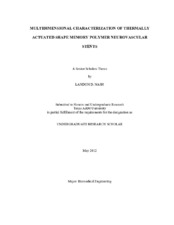| dc.description.abstract | In this work, shape memory polymer neurovascular stent prototypes based on a previously proposed design were thermo-mechanically characterized to expand on the clinical efficacy of the device. The stents were made by dip-coating pins in a thermoplastic polymer solution and subsequently covalently crosslinking the polymer using UV irradiation to yield thermoset tubes. These crosslinked tubes were CO2 laser engraved to produce the complex stent geometry.
Experiments were conducted to determine the physiologically relevant mechanical behavior of these devices. Three point bend tests were performed to determine the longitudinal flexibility of deployed stents at room temperature and body temperature. The resulting longitudinal flexibility data was compared to currently available stent systems. Radial behavior tests were conducted on stent prototypes and polymer tubes using a radial compression system that interfaces with a tensile tester. Crimping and radial recovery behavior experiments measured the pressure exerted by the device as a function of strain recovery at discrete temperatures. Crimped polymer tubes, representing idealized polymer stents, were deployed in the compression station at fixed diameters. These tests represented the constrained recovery environment of an occluded vessel and quantified recovery pressures as a function of temperature. Material characterization techniques such as dynamic mechanical analysis, tensile testing, and gel fraction studies were employed to further quantify the clinical relevance of this device.
These devices proved to have longitudinal flexibility values comparable to or better than many stents currently available on the market, which makes them attractive for neurovascular applications requiring navigation of tortuous vessels. Additionally, Shape memory tests demonstrated a one second device deployment, which minimizes the amount of heat introduced into the body. This study also provides a body of data useful for further optimization of this medical device, such as desirable crimping pressures, optimal crimping temperatures, and device deployment pressures. | en |


